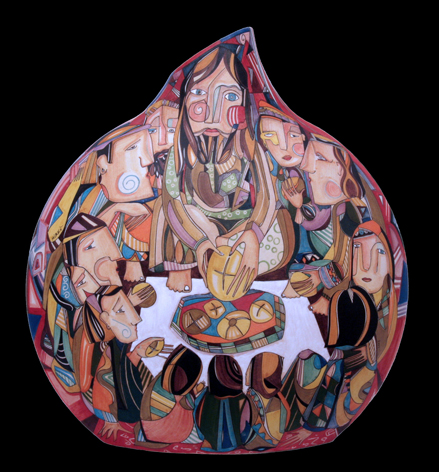This morning I poured water into an ordinary glass, and I was suddenly struck by what an astounding container it is. This tumbler is not very special. We bought a set of them years ago in some store like Target. But it is a miracle of design nonetheless: a thin shell, surprisingly durable, perfectly transparent, strong, cool and smooth to the touch. When I examine it more closely I see that it is marred by tiny scratches, no doubt from all the use it has had, and that at the rim there is another imperfection, a smattering of tiny bubbles that catch the light like stars. It holds my water as it would hold anything, with no alteration in its nature. It simply receives whatever is put into it and carries it.
In Mark’s account of Jesus’ final meal with his disciples a container even more astounding is built. Jesus has gathered his community. Like all intimate groups of people it contains dark and secret motives, desires and frustrations of every type. In fact, this gathering is like a little time bomb. Everything necessary for its destruction is packed right in with it. There’s a man who loves Jesus and rests against his breast, another who loves him deeply but will soon deny that he knows him, other men who will flee from the violence that will soon surround him, and a betrayer who will set the disaster in motion.
Jesus knows this. He knows about the betrayer and can point out who it is. He knows about the denial and the running away. He knows who will be there with him at the end and how their hearts will be broken. He knows he will no longer be around to be the center of his community. So he builds them a container. It is ordinary and transparent like my water glass. It will hold anything, and over the centuries it certainly has. For this container is more durable than objects made of stone or glass or even fine metals. It holds people together in community when otherwise, because of their profound differences, they would fly apart forever.
Jesus builds it of the elements of the table fellowship of the Passover Feast. He takes two and transforms them, constructing a shell infused with his very being. “This is my body,” he says, passing around a loaf of bread he has blessed. Then he passes them a cup of wine, and all of them drink from it. “This is my blood of the covenant, which is poured out for many,” he tells his followers.
“This is my body.” “This is my blood.” Like my water glass, this container is durable and transparent, a miracle of design. It held that contentious people with their petty longings and their destructive ways after their Master was gone. It made of them a body, the followers of the Way of Christ. It has held millions of other communities through the ages and it holds us all still.
There are, of course, many differences between my water glass and this mystical container that Jesus built. The most powerful is this: the container of the Eucharist does not leave its contents unchanged. Invisible as it is, it transforms everything held by it. The very fabric of it is Christ himself. Its very essence is love.

